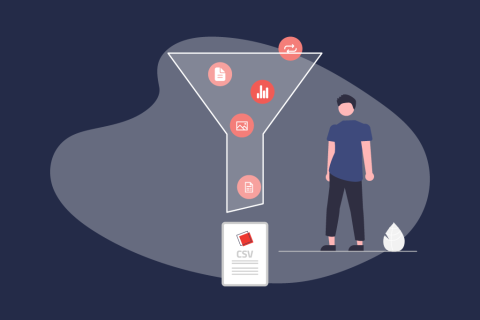Product Communications
Product Classifications – Universal Standards for Your Data

Content
The Product Classification Brings Order into Your Product Data
Every manufacturer and retailer of a product knows the ins and outs of what it has to offer. They are well familiar with the properties which perfectly describe their product and which make its uniqueness vividly graspable. Naturally, the company’s naming conventions, own neologisms, and individual style do also determine what the description of the product assortment looks like. All these aspects are important when it comes to differentiating your brand from the competition and conveying the feeling the brand stands for. After all, the kitchen chair is not simply brown: it has a warm color with a hint of red shimmering through – a chestnut brown. Or your product may feature other unique characteristics. For example, the grip of the hammer is made out of reinforced plastic, allowing its owner to also use it near wires which conduct electricity.
Together, they function as an important decision-making criterion for your customers to select the right product. On the basis of this information, they can compare products – within your own assortment, but also with other product offers on the market. And this is where the product classification comes into play: it’s what grants your product data and information the required structure. It forms the perfect foundation for smooth data refinement in your PIM or ERP system and also guarantees a fast data transfer for optimal presentation in your online shop or e-catalog. In short: For those in the e-commerce and e-business world who want to market products internationally and globally, product classification is an uncircumventable topic. Further benefits include that your products will be presented in a much clearer and more distinct manner, be it in your own internal system or external sales channels. This, in turn, translates into higher customer conversion rates. How exactly product classifications function, what advantages they have to offer, and how you can profit from them – find out all this and more if you keep on reading.
What is a Product Classification?
When classifying products, they’re organized into so-called group structures and categories. In the process, each data record of your data pool is assigned to its respective category with specific properties. The product classification hereby allows you to find and compare product information more easily, while also simplifying and unburdening the entire data traffic going on between the systems of manufacturers, online shops, marketplaces, suppliers, and retailers.
Most commonly, data is organized in so-called standard classifications such as GPC, UNSPSC, or ETIM. These are centered around industry-specific criteria, providing you with a classification method which fits your company’s needs. The data exchange, in turn, is simplified with standardized exchange formats such as BMEcat.
How Product Classifications Prove to be Useful for You
For directly and automatically transferring your product portfolio into e-procurement systems (e.g. of wholesale retailers), a standardized description is necessary. To this end, there are product classifications by classification standards used within the respective industry. One example is the standardization developed by ETIM e.V., utilized for facilitating the product data exchange between the two industries of electrical installation as well as HVAC or sanitary engineering. In this particular case, we’re looking at an ID-based data model composed out of product classes, attributes, and attribute values.
Of course, there are also other classification standards. Other prominent examples include ECLASS, GPC, and profiCl@ss, which are employed in their respective industries. More often than not, they come with their own unique classification principle (while others build on and modify existing classifications, e.g. the XML format developed by ARGE Neue Medien was originally build out of the ETIM classification). By now, you may already have realized just how diverse the field of data processing really is. In order to make your journey through this field as simple and efficient as possible, you should first answer the following question before anything else: Which product classification do I need? How should the classification be structured in more detail? And how do I map my own data model onto it in the best possible manner?
This is how Product Classifications and Exchange Formats Synergize
Which product classifications you need is often times dictated by the market. It may be the case that a retailer or manufacturer demands a specific data format. A best practice example is to combine BMEcat with ETIM.
The widely used BMEcat format is applied to create e-catalogs. BMEcat has been slightly modified and expanded by ETIM in order to fit the requirements of all the industry-specific software systems involved. Usually, the product group structure is determined and parsed into the BMEcat format by the company which provides the data. However, in the use case of combining BMEcat with ETIM, this is no longer necessary, since ETIM already comes with the definition of such a group structure in its standard. No extra effort required. The receiving systems can already interpret the ETIM standard with their built-in means alone and can directly identify which article is to be assigned to which ETIM product group etc. In an ideal scenario, all suppliers agree upon operating with the same classification standard, meaning that all searches for orderable articles in e-procurement systems work with one and the same structure.
Another lesson you can take from this is that you need to be well familiar with both, your own data model and relevant product classifications. And this is where the use of a PIM systems (Product Information Management) can be extremely helpful.
Nothing Short of Classy: PIM and Classifications
PIM software serves the purpose of organizing your data in a data model in accordance with your product requirements. This way, you can map your products perfectly in a use-case neutral manner, without already having to worry about data exports and product classifications. Instead, you can approach the matter in a follow-up step, where you develop a mapping with which you can assign any given product attribute from your existing data structure to the required attributes of the respective classification. For example, the classification may only know the color brown; but in the terminology of your own data model, the product has the attribute chestnut brown; so, in the mapping, you can simply determine that the attribute chestnut brown is to be mapped onto and exported as brown.
In such a manner, you can map your entire data pool to a relevant classification’s requirements in step-by-step manner. In order to support you in this process, we’ve developed a method for our eggheads Suite which makes the mapping of your data as smooth as possible. Once the mapping is set up, you can automatically parse any set of relevant data records into the target classification and export it to target channels at the click of a few buttons.
Are classifications a topic on your current agenda? If so, don’t hesitate to contact us. Our experts have years’ worth of expertise in this field and are always happy to provide you with help when it comes to overcoming challenges revolving around product data. No obligations on your end. Here’s our contact form.
From Our Blog
You may also be interested in the following articles






